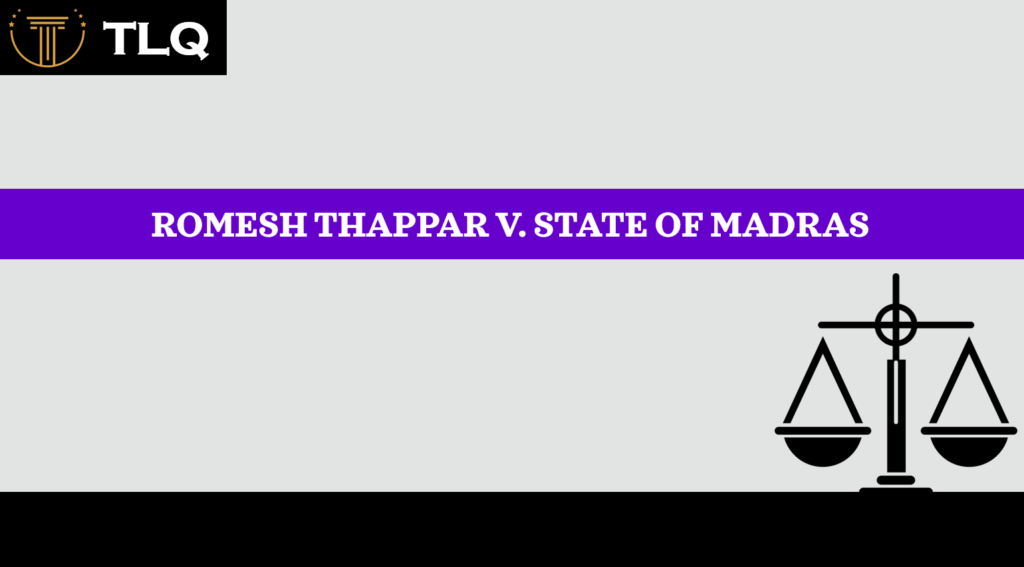Published On: 5th August, 2024
Authored By: Vivek V. Yadav
DR. D. Y. Patil College of Law
Introduction
Judicial review is a key element of constitutional governance, showing that the courts have the power to evaluate and invalidate laws and actions made by the government if they go against the Constitution. In India, the judicial review is crucial for upholding the rule of law and ensuring that each branch of government complies with its constitutional limits.
The beginning of judicial review can be linked to the concept of checks and balances, a system designed to prevent any one branch of government from becoming too powerful. This system plays a vital role in a democracy by protecting individuals’ rights and freedoms from arbitrary and unjust government actions.
The historical development of judicial review in India shows an active interrelationship among the judiciary, legislature, and executive, which has influenced the country’s constitutional framework.
The legal foundation for the review of laws by the judiciary.
In India, the concept of judicial review is not expressly stated in one provision but is suggested through multiple provisions of the Constitution.
Article 13 discusses the authority of Judicial Review.
Article 13 of the Indian Constitution states that any law that conflicts with or undermines fundamental rights is invalid. This rule is the foundation of judicial review in India. The Supreme Court and High Courts can review laws to confirm they align with fundamental rights.
Article 32 and 226: Writ Jurisdiction
Articles 32 and 226 give the Supreme Court and High Courts the authority to issue writs for the protection of fundamental rights and legal rights, respectively. These legal orders consist of Habeas Corpus, Mandamus, Prohibition, Certiorari, and Quo Warranto. These measures allow the judiciary to assess and guarantee that executive and legislative actions adhere to constitutional standards.
Article 136: Special Leave Petition
Article 136 gives the Supreme Court the authority to provide special permission to appeal decisions made by any court or tribunal. The Supreme Court has the power to determine if laws and executive actions are constitutional.
Article 226 and 227: High Courts’ Powers
Article 226 authorizes High Courts to issue writs for the enforcement of fundamental and legal rights. Article 227 gives High Courts the power to supervise lower courts and tribunals, making sure they follow the law.
The important role of the Supreme Court and High Courts is to carry out judicial review, guaranteeing that all government actions comply with the Constitution’s requirements.
Evolution of Judicial Review in India
The development of judicial review in India can be seen through specific stages, each characterized by important court decisions and changes to the constitution.
Pre-Independence Era
The origins of judicial review in India can be traced back to the colonial period when British courts began to exercise limited judicial supervision over legislative actions. The Government of India Act, 1935, established the groundwork for a federal court system, which later influenced the judicial review system put in place post-independence.
Developments that occurred after gaining independence.
Following independence, the framers of the Indian Constitution integrated judicial review into the constitutional framework, drawing inspiration from the American system and adapting it to fit the requirements of India. In its infancy, the judiciary cautiously started to exercise its power of review.
Landmark Cases
A number of important cases have greatly influenced the doctrine of judicial review in India.
In the case of A.K. Gopalan v. State of Madras (1950), the Supreme Court emphasized procedural due process over substantive due process in its interpretation of judicial review.
The cases of Shankari Prasad v. Union of India (1951) and Sajjan Singh v. State of Rajasthan (1965) confirmed the authority of Parliament to amend the Constitution, including fundamental rights.
In Golak Nath v. State of Punjab (1967), the Supreme Court changed its previous position and stated that Parliament was not allowed to modify fundamental rights through amendments.
In the case of Kesavananda Bharati v. State of Kerala (1973), a crucial ruling was made introducing the Basic Structure Doctrine, emphasizing that although Parliament has the power to modify the Constitution, it is not permitted to change its fundamental framework.
In the case of Minerva Mills Ltd. v. Union of India in 1980, the court upheld the significance of judicial review as a crucial element of the Constitution’s basic structure by reaffirming the Basic Structure Doctrine.
The 1994 S.R. Bommai Case: The Supreme Court defined the extent of judicial oversight on the dissolution of state legislatures and the enforcement of the President’s Rule in S.R. Bommai v. Union of India (1994). The Court ruled that the President’s decision must rely on objective circumstances and can be scrutinized by the judiciary.
Scope and Extent of Judicial Review
Judicial review in India covers a wide range of government actions, including legislative, administrative, and constitutional issues.
Review of Legislative Actions
The courts are empowered to assess the constitutionality of legislative decisions. This involves closely examining both Central and State laws to guarantee they align with the Constitution, specifically with fundamental rights. The judicial branch has the power to nullify laws that are deemed to violate the Constitution.
Review of Administrative Actions
Judicial review applies to administrative actions such as executive orders, policies, and decisions. Courts assess if such actions comply with the law, follow principles of natural justice, and do not infringe on constitutional provisions.
Judicial Review of Constitutional Amendments
One critical component of judicial review in India is how it is applied to constitutional amendments. The Basic Structure Doctrine, outlined in the Kesavananda Bharati case, protects vital components of the Constitution from alteration by amendments, thereby preserving the core principles of the Constitution.
Principles Governing Judicial Review
Various legal principles in India regulate the procedure of judicial review, guaranteeing that the judiciary adheres to its constitutional duties.
The doctrine of Basic Structure
This principle asserts that although Parliament can change the Constitution, it is not allowed to modify its fundamental framework. This involves basic principles like the Constitution’s supremacy, rule of law, division of powers, and fundamental rights.
Doctrine of Proportionality
This principle states that administrative actions should be in proportion to their intended goals. Courts evaluate if the actions taken are needed and suitable, as well as if there are fewer limiting options.
Doctrine of Legitimate Expectation
The principle of legitimate expectation safeguards people from arbitrary administrative decisions. It guarantees that individuals can anticipate a public authority’s action to align with its promises unless there is a legitimate reason for a change.
Judicial Review and Fundamental Rights
Judicial review is essential in safeguarding basic rights by enforcing the rights outlined in the Constitution. The judiciary can invalidate laws and government actions that go against core rights, allowing people to seek justice for any violation of their rights.
The judicial branch also has a notable responsibility in interpreting and implementing the Directive Principles of State Policy, which, while not legally enforceable, provide guidance for the government in forming policies. Judicial review maintains the alignment of these principles with basic rights, advancing social equity and well-being.
Judicial Activism vs. Judicial Restraint
The discussion regarding judicial review is primarily focused on the argument between judicial activism and judicial restraint. Judicial activism is when the judiciary takes on a proactive role in promoting justice, sometimes encroaching on the responsibilities of the legislature or executive branch. On the flip side, judicial restraint supports a narrow function for the courts, highlighting the importance of honoring the division of powers.
Notable Examples and Criticisms
Several progressive judgments, like the Vishaka guidelines on sexual harassment and the decriminalization of homosexuality in Navtej Singh Johar v. Union of India, have been the result of judicial activism. Nevertheless, it has also been criticized for judicial overreach, as courts are perceived to interfere with the roles of the legislature and executive.
Challenges and Criticisms
Even though it plays a crucial role, judicial review in India encounters various challenges and criticisms.
Judicial Overreach
Debates on the balance of powers have been triggered by occurrences of judicial overreach when the judiciary is believed to have exceeded its constitutional authority. Critics claim that too much interference from the judiciary weakens the power of the legislative and executive branches.
Backlog of Cases
The Indian judiciary is overwhelmed with a large number of pending cases, which leads to delays in the dispensation of justice. This backlog hampers the effectiveness of judicial review, resulting in delays in resolving crucial constitutional and legal matters.
Balance of Powers
Keeping the distribution of powers equal between the three branches of government is always a difficult task. Judicial review must carefully maintain this delicate balance, making sure not to infringe on the roles of the legislative and executive branches while also upholding the Constitution.
Recent Trends and Future Directions
The legal practice of reviewing court decisions in India is constantly developing, mirroring shifts in societal beliefs and legal rules.
Evolving Jurisprudence
In the past few years, the court has broadened its understanding of basic freedoms, including privacy, equality, and freedom of speech. This developing legal system has strengthened the importance of court review in safeguarding personal freedoms.
Technology and Judicial Review
The emergence of technology brings fresh challenges and possibilities for judicial scrutiny. The court system needs to adjust to technological progress, making sure that online rights are safeguarded and that technology is used to improve the effectiveness of the legal system.
Potential Reforms
Numerous suggestions have been made to enhance the system of judicial review. Some of these measures consist of enhancing the power of the courts, implementing other conflict resolution methods, and using technology to simplify legal procedures.
The Role of Judicial Review in Protecting Fundamental Rights
Judicial review is crucial for safeguarding fundamental rights by providing the opportunity for individuals to challenge any violations of their rights. The legal system acts as a defender of the Constitution, protecting fundamental rights from violations by the government and other entities.
Conclusion
Judicial review is a crucial tool within India’s democratic system, with the purpose of guaranteeing that government decisions comply with constitutional principles and safeguard individual freedoms. The development of judicial review in India demonstrates a fluid equilibrium among the legislature, executive, and judiciary, underscoring the judiciary’s function as a guardian of the Constitution.
Through significant court decisions and changing legal understandings, the Indian court system has emphasized the significance of judicial review in maintaining the fundamental structure of the Constitution, safeguarding basic rights, and verifying the legality of government actions. Even though there are limitations to judicial review, it is still an important tool for upholding the rule of law and ensuring justice in the Indian legal system.
As new challenges and constitutional issues arise, the future of judicial review in India is predicted to continue evolving. The Indian democratic system will still focus on safeguarding individual rights and promoting constitutional values as a crucial aspect of the judiciary’s duties.




